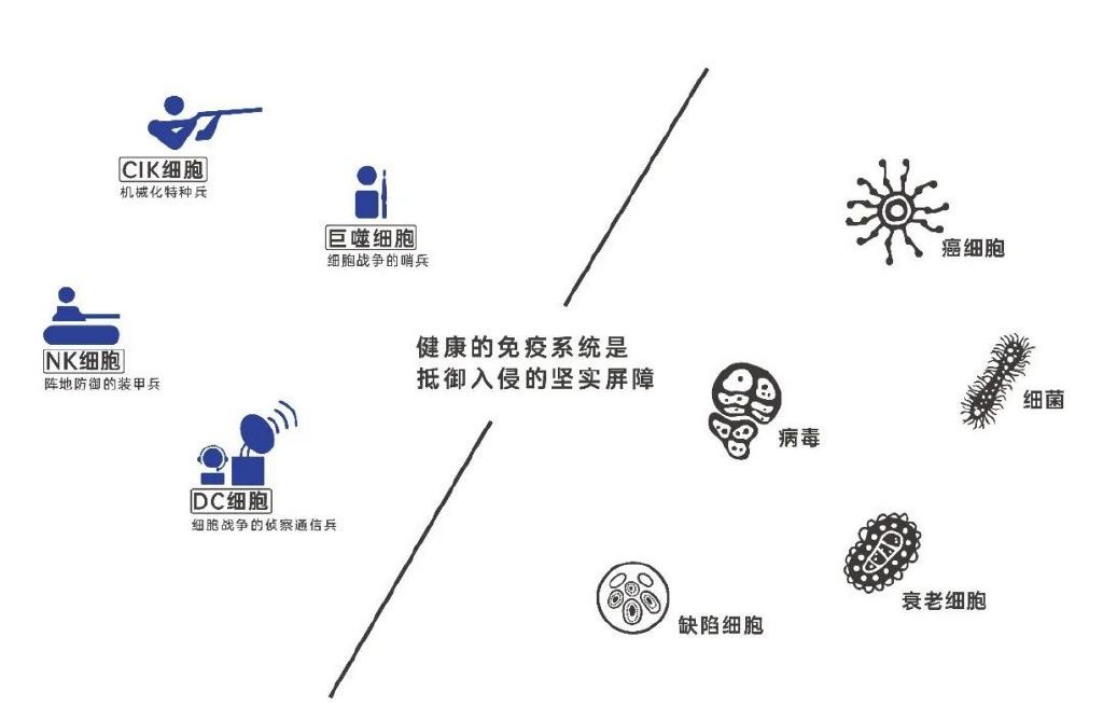Arguments for Cellular Health
The human immune system is akin to a defense system composed of countless immune cells, constantly fighting against various viruses and harmful bacteria. In these smokeless battles at the cellular level, there are macrophages acting as sentinels, DC cells serving as reconnaissance soldiers, NK cells functioning as armored defenders, and CIK cells operating as mechanized special forces.

Introduction to Stem Cells
The term "stem cell" is derived from the English word "stem," meaning "trunk" or "origin." The function of stem cell populations is to control and maintain cell regeneration. Stem cells possess the ability to self-renew, although their division is relatively asymmetric. In simple terms, stem cells are a class of cells that have unlimited or immortal self-renewal capabilities and can produce at least one type of highly differentiated progeny cell. Based on the developmental stage, stem cells can be classified into embryonic stem cells and adult stem cells.
Embryonic Stem Cells
Among various types of stem cells, embryonic stem cells are the most notable in research and application. Embryonic stem cells are derived from the inner cell mass of an embryo or primordial germ cells through in vitro culture and selection. Additionally, embryonic stem cells can be obtained using somatic cell nuclear transfer technology. Embryonic stem cells have totipotency, theoretically capable of differentiating into all types of cells in the body. They can be massively expanded, selected, frozen, and revived in vitro without losing their original characteristics.
Adult Stem Cells
Adult stem cells are undifferentiated cells found in differentiated tissues, capable of self-renewal and differentiation into the cell types that constitute the respective tissue. Adult stem cells exist in various tissues and organs of the body. The main types of adult stem cells discovered include hematopoietic stem cells, bone marrow mesenchymal stem cells, neural stem cells, liver stem cells, muscle satellite cells, skin epidermal stem cells, intestinal epithelial stem cells, retinal stem cells, and pancreatic stem cells.
Totipotent Stem Cells
Totipotent stem cells have the ability to self-renew and differentiate into any cell type, with the potential to form a complete organism. Examples include embryonic stem cells, which have similar morphological characteristics to early embryonic cells and strong differentiation capabilities. They can proliferate indefinitely and differentiate into over 200 cell types in the body, eventually forming all tissues and organs.
Multipotent Stem Cells
As the name suggests, multipotent stem cells can produce multiple cell types but have lost the ability to develop into a complete organism, with limited developmental potential. For example, hematopoietic stem cells can differentiate into at least 12 types of blood cells, and bone marrow mesenchymal stem cells can differentiate into various mesodermal tissue cells (such as bone, cartilage, muscle, fat, etc.) and cells of other germ layers (such as neurons). Scientists tend to refer to stem cells with broader differentiation potential as pluripotent stem cells, such as bone marrow mesenchymal stem cells, and stem cells that differentiate into different cells of one tissue type as multipotent stem cells, such as hematopoietic stem cells and neural cells.
Unipotent Stem Cells
Unipotent stem cells are often used to describe a class of cells in adult tissues and organs that can only differentiate in one direction, producing one type of cell. Many adult stem cells in differentiated tissues are typical unipotent stem cells, capable of producing only one type of cell under normal conditions. Examples include basal layer stem cells in epithelial tissues and myogenic cells in muscles, also known as satellite cells. These tissues are in a stable state of self-renewal, but if the tissue is damaged and requires multiple cell types for repair, their potential may be further realized.



